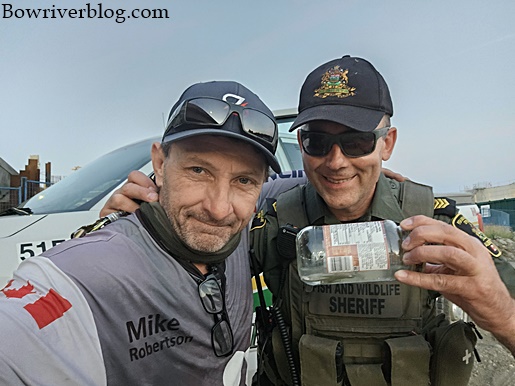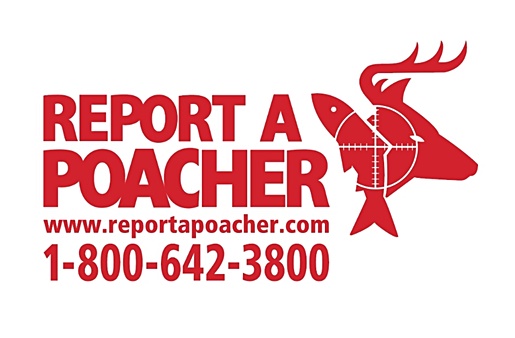
Recently I have seen an increase in poaching on the Bow River while out fishing. Poaching is bad for our fisheries and can cause severe decline in fish populations rapidly. Not only is it against the law, but it is also harmful to any fishery, especially when the Bow River is in a steady decline, and our government is not actively stocking the watershed.
Poaching is defined as taking/killing a fish or animal illegally and can take on many forms. Fishing without a license or tag, exceeding the set limit, fishing out of season, fishing for trout when restrictions are in place (IE, fishing when Time Of Day restrictions are in place) snagging fish, harvesting someone else’s limit, using bait or baitfish where prohibited, or scented lures/ plastics, retaining fish where prohibited, using more hooks on one line then allowed, not following size limits – all are examples of poaching.
In 2017, the Alberta Fish and Wildlife implemented a Catch and Release policy ONLY on the Bow River system from Bow Lake all the way to the Bassano Dam. No fish of any kind including Pike may be kept. Also, no bait of any kind may be used, including Maggots which were the ONLY bait allowed previous, and only from September 1st to October 31st.
I had two incidents lately where I observed two anglers clearly breaking the law. A third incident where I had strong suspicions that the angler was going to keep a fish illegally.
The first incident my girlfriend and I were going fishing in the evening, inner city Calgary. We arrived at the Bow River at about 7pm. We walked down the Bow River pathway and through some thick brush to get to the rivers edge. This spot is surrounded with high trees along the bank, and as we were about to go over the berm of the bank, I observed an angler standing beside his rod, not casting or retrieving. This is a dead giveaway that the angler had bait out into the river, where it is not legal to do so. I walked away from the berm of the bank and immediately called the Report A Poacher number. After giving the location where we were, and where the person bait fishing was, I received a call-back from the Calgary Fish and Wildlife officer. Lucky he was in the area and took him a short five minutes to show up. I directed him to where the poacher was fishing and in fact, the guy was using minnows as bait. The officer then wrote him a ticket and came and chatted with me regarding what he found; minnows stashed in a glass jar, hidden under some tree roots on the bank. After talking with the Fish and Wildlife officer briefly, he notified me that this guy is a repeat offender and was caught keeping more fish then was legal. I guess some poachers never learn.
The second instance, just a few weeks ago, I went shore fishing inner city. I was alone and made my way up the river pecking my way along to find fish. I was casting my Robertson tackle lures out and noticed a guy fishing upriver from me. What first caught my attention was he was not casting, nor was he retrieving like I. For me, it’s the first tell-tale sign that bait is possibly being used. As I got closer to him, I noticed he was getting more nervous and keep looking downriver at me. I walked down to my backpack and called the Report a Poacher number.

Let’s pause here and talk about the things you should have ready before you call the R.A.P number.
- A description of the person or persons involved in the infraction. What color clothes they are wearing, race, ball cap, etc.
- Make and model of vehicle if you can, or licence plate. This seldom happens as we are often away from the vehicles.
- Where you are located, and where the possible offender is located also. Google maps is super helpful, or letting the officer on the phone know what area you are in. EG (I am on the east side of the river, under the Sue Higgens bridge. This information is valuable and can save time when the field officer responds.
- What you saw, or seeing while you are on the phone. Sometimes the offender will keep the fish, so watching where the fish was placed can be helpful for the responding officer.
By the time I made the call to the R.A.P number, it was already 8pm and it took the responding officer about an hour to get to the location. By this time, the guy I suspected changed locations and walked past me and went downriver. I was parked in a parking lot near the river, and once the officer pulled in, I directed him to the location of the suspect. The guy was in fact using bait and admitted that he caught a rainbow trout, which he hooked deep and blead out on the shore. He told the officer he released the fish, and the fish he caught was bleeding heavy. Another trout perished because of breaking the rules. Once again, the guy was a repeat offender.
The third incident happened in the exact same location as the second. My friend and I were shore fishing in the evening and saw a guy catch a fish across the river from us. He had no net and dragged the fish onto the shore for almost four minutes. I never saw him release the fish, so I decided to make the call to the R.A.P number and report the incident. Four minutes having a trout out of the water is almost sure death. I’m not God, nor do I play God, but the chances of a fish surviving after that is not good. Having a net and keeping the fish in the water while you remove the hook is the solution here. A short fifteen minutes and the officer had arrived. I pointed out the angler and he went straight over and checked for fish, and licences. I said to my friend, “watch, I bet they don’t have licences”. Sadly, I was right, and two tickets were issued to two anglers.
It is a big river system here on the Bow, and we know the trout populations are in a decline. If one trout is killed each day, every season approximately 245 fish will be lost. It does not seem like a big deal, but over a five-year span, that is 1225 fish gone. My point here is this, if everyone cares and does their part to preserve the fishery, we will hopefully have a steady trout population for many years to come.
Here’s where you come in. Alberta Fish and Wildlife officers can’t be everywhere. They depend on river users, anglers and other wildland enthusiasts to report poaching and other suspicious behavior they see in the field. It’s super important to protect our fisheries at all costs.
To conclude, using bait kills fish. They take the bait deep and that increases mortality. It is illegal here on the Bow River system from Bow Glacier to the Bassano Dam. In a catch and release fishery, bait has been banned.
Keeping the fish out of the water too long can kill fish. Get a good rubber meshed net and leave the fish in the water, breathing. Have needle-nose pliers ready and your camera if you desire to take a quick photo. Do not handle the fish longer than necessary. Come prepared with the right gear and the right tools. Use appropriate pound test line for your fishing applications. I suggest 8lb test line minimum for trout fishing the Bow River. The last thing we want is to break off, leaving a hook in a trout’s mouth, rendering the fish not able to eat again.
Do your part and report all infractions to the Alberta Report A Poacher number here at 1-800-642-3800. You are eligible for a reward if tickets are given, and the poacher has been charged. Personally, I do not do it for the money, I do it for the love of the fishery and to protect angling opportunities for many generations to come. Educate your fishing friends, and or family, about the importance of the fisheries and maintaining what we have. Share this article and pass on this valuable information to others, in hopes they learn and follow the laws and rules set in place. If you don’t like the rules, or you feel they need to be changed, address your grievances with your local F&W office, your local M.L.A or the environment minister. You can also get involved in the local fishing clubs and offer your time to enhance and protect the fisheries around you. There are many ways to keep fishing alive for many years into the future. Please learn the rules before you fish, and if they are unclear, or you have questions, please call the local fish and wildlife office and ask someone. They will clarify the rules for you, so you understand and stay within the regulations and the law.
Thank you,
~Mike
